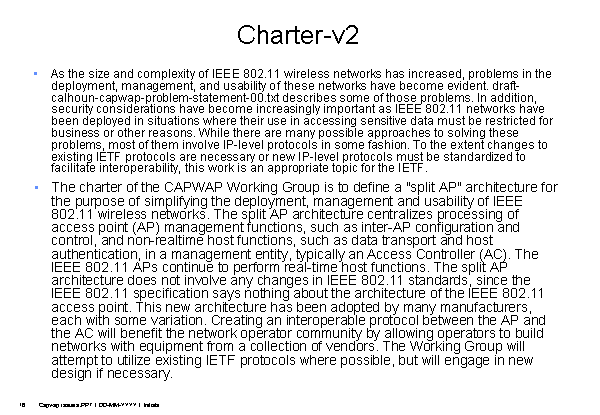




capwap-4----Page:16
1 2 3 4 5 6 7 8 9 10 11 12 13 14 15 16 17 18 19
|
Charter-v2 As the size and complexity of IEEE 802.11 wireless networks has increased, problems in the deployment, management, and usability of these networks have become evident. draft-calhoun-capwap-problem-statement-00.txt describes some of those problems. In addition, security considerations have become increasingly important as IEEE 802.11 networks have been deployed in situations where their use in accessing sensitive data must be restricted for business or other reasons. While there are many possible approaches to solving these problems, most of them involve IP-level protocols in some fashion. To the extent changes to existing IETF protocols are necessary or new IP-level protocols must be standardized to facilitate interoperability, this work is an appropriate topic for the IETF. The charter of the CAPWAP Working Group is to define a "split AP" architecture for the purpose of simplifying the deployment, management and usability of IEEE 802.11 wireless networks. The split AP architecture centralizes processing of access point (AP) management functions, such as inter-AP configuration and control, and non-realtime host functions, such as data transport and host authentication, in a management entity, typically an Access Controller (AC). The IEEE 802.11 APs continue to perform real-time host functions. The split AP architecture does not involve any changes in IEEE 802.11 standards, since the IEEE 802.11 specification says nothing about the architecture of the IEEE 802.11 access point. This new architecture has been adopted by many manufacturers, each with some variation. Creating an interoperable protocol between the AP and the AC will benefit the network operator community by allowing operators to build networks with equipment from a collection of vendors. The Working Group will attempt to utilize existing IETF protocols where possible, but will engage in new design if necessary. |